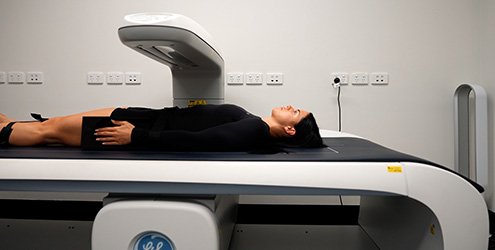Community
Copyright@ Australian Catholic University 1998-2025 | ABN 15 050 192 660 CRICOS registered provider: 00004G | PRV12008
Copyright@ Australian Catholic University 1998-2025 | ABN 15 050 192 660 CRICOS registered provider: 00004G | PRV12008

When ACU PhD student Nicholas Berlin began researching the complex relationship between high performance athletes and bone health, he was aiming to help shape new understandings in Australian athletes’ health, wellbeing and performance.
In partnership with the Queensland Academy of Sport (QAS), Nicholas is exploring how a DXA machine – traditionally used in hospitals and clinics – could transform the way we monitor the wellbeing of elite athletes.
“I’m looking at how we can use DXA as a tool to better inform bone status, or to identify potential athletes who are at risk of negative outcomes such as fractures,” he explained.
“DXA is a well-developed tool and there’s lots of research to support its use in elderly populations to diagnose osteoporosis and abnormal or declining bone mineral density.
“But information available for athletes is limited and future research is needed.”
DXA, short for dual-energy X-ray absorptiometry, also known as DEXA, is a low-dose radiation tool that can identify different body compartments including overall body composition, bone content, and lean and fat mass.
It has been a key tool in hospitals to assess bone density, which is linked to increased risk of fractures.

However, its full potential to be utilised in a high-performance sports setting is still being realised.
As part of his research, Nicholas has been assessing how DXA scans are currently used in sport and whether there is greater application of its use in the bone density space.
Currently, athletes face many challenges when obtaining the ‘gold standard’ spine and femur scans due to healthcare guidelines.
“One big concern that’s been a bit of a cloud is how difficult it is for athletes to access a DXA spine and femur scan,” he said.
“We know that these are the gold standard for multiple different reasons.
“Athletes typically get access to scans after they’ve had a fracture, so quite often it’s too little too late.
“We’re really trying to see if we can use DXA as more of a preventative tool or at least to provide some information before anything like a fracture occurs.”
Nicholas’s research has already revealed important gaps in how DXA is used across sport science.
One of his early projects looked at “how well the research reports methodology to reduce error with the machine” and how an athlete presents to their DXA scans.
“We have technical error, which includes the expertise of the technician, participant positioning, precision error, and quality assurance and control when calibrating the machine.
“Then there’s also biological variation in humans as we fluctuate from day to day.
“Prior exercise and dietary intake can affect muscle stores and, if not standardised, can make interpretation of data challenging.
“My first PhD mission was to embark on a journey that investigated how well the literature reports these factors.”
Nicholas is aiming to contribute to best practice guidelines for DXA in high performance sport.

The end goal is to create a normative database of both body composition and bone mineral density that will help inform athlete-specific scenarios across a variety of sports.
His research is a possible game changer as current DXA reference databases reflect the general population and therefore are not appropriate to compare to the nuances that athletes face in their daily environments.
It could provide insight for coaches and medical teams to make smarter decisions about training loads, recovery, health and performance.
Nicholas credits his partnership with the Queensland Academy of Sport for giving his research both depth and impact.
The collaboration allows him to work closely with elite athletes and performance specialists, applying his findings in real-world environments.
“One thing, at least in the DXA literature, is there probably needs to be a bit more done with high-performance athletes,” he said.
“There is plenty of evidence available for the general population but partnering with QAS gives me access to this really niche population of some of the best athletes in the state, the country, the world.
“Being able to collaborate with QAS and provide a service which will not only help athlete health and wellbeing and performance, but will enhance our knowledge and understanding and research within this population, has been interesting.”
Now halfway through his PhD, Nicholas has completed two major projects and is preparing for the next phase of research – one that will take his work nationwide.
“We want to create athlete-specific data with DXA, but before we do that, we really need to figure out how best to do that,” he said.
“For example, the other day I did a femur scan – just a single femur. But we also have the option to do a dual femur.
“This is important in terms of athletes that might have a dominant leg versus a non-dominant leg and other differences in those bone mineral densities between those two legs.
“Currently we don’t know what the best approach is in this space and I’m hoping to tackle that in the future.”
Keen to pursue a career in elite sport and gain access to some of the world’s leading researchers and practitioners? Explore the options.
Copyright@ Australian Catholic University 1998-2025 | ABN 15 050 192 660 CRICOS registered provider: 00004G | PRV12008